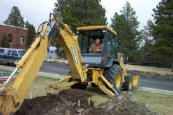|

|
|
RECOMMENDED MONITORING AND
SPOT CHECK PROCEDURES FOR
CONSTRUCTION AND EXCAVATION
In order to insure a smooth flow of operations, the following
procedures are recommended in the event that potentially significant cultural
deposits or human burials are found during the development:
-
 Monitoring will consist of directly
watching the major excavation process. Monitoring will occur during the entire
work day, and will continue on a daily basis until a depth of excavation has
been reached at which resources could not occur. This depth is estimated as
usually about five feet below grade at the beginning of the project, but may
require modification in specific cases, and will be determined by the
monitoring archaeologist based on observed soil conditions. Monitoring will consist of directly
watching the major excavation process. Monitoring will occur during the entire
work day, and will continue on a daily basis until a depth of excavation has
been reached at which resources could not occur. This depth is estimated as
usually about five feet below grade at the beginning of the project, but may
require modification in specific cases, and will be determined by the
monitoring archaeologist based on observed soil conditions.
- Spot checks will consist of partial monitoring of the progress of
excavation over the course of the project. During spot checks all spoils
material, open excavations, recently grubbed areas, and other soil
disturbances will be inspected. The frequency and duration of spot checks will
be based on the relative sensitivity of the exposed soils and active work
areas. The monitoring archaeologist will determine the relative sensitivity of
the parcel.
- If prehistoric human interments (human burials) are encountered within the
native soils of the parcel, all work should be halted in the immediate
vicinity of the find. The County Coroner, project superintendent, and the
Agency Liaison should be contacted immediately. The procedures to be followed
at this point are prescribed by law.
- If significant cultural deposits other than human burials are encountered,
the project should be modified to allow the artifacts or features to be left
in place, or the archaeological consultant should undertake the recovery of
the deposit or feature. Significant cultural deposits are defined as
archaeological features or artifacts that associate with the prehistoric
period, the historic era Mission and Pueblo Periods and the American era up to
about 1900.
- Whenever the monitoring archaeologist suspects that potentially
significant cultural remains or human burials have been encountered, the piece
of equipment that encounters the suspected deposit will be stopped, and the
excavation inspected by the monitoring archaeologist. If the suspected remains
prove to be non significant or non cultural in origin, work will recommence
immediately. If the suspected remains prove to be part of a significant
deposit, all work should be halted in that location until removal has been
accomplished. If human remains (burials) are found, the County Coroner must be
contacted so that they (or a designated representative) can evaluate the
discovered remains and implement proper contacts with pertinent Native
American representatives.
- Equipment stoppages will only involve those pieces of equipment that have
actually encountered significant or potentially significant deposits, and
should not be construed to mean a stoppage of all equipment on the site unless
the cultural deposit covers the entire building site.
During temporary equipment stoppages brought about to examine suspected
remains, the archaeologist should accomplish the necessary tasks with all due
speed.
If you have questions about whether your project needs monitoring or spot
checking, please contact us.
|
